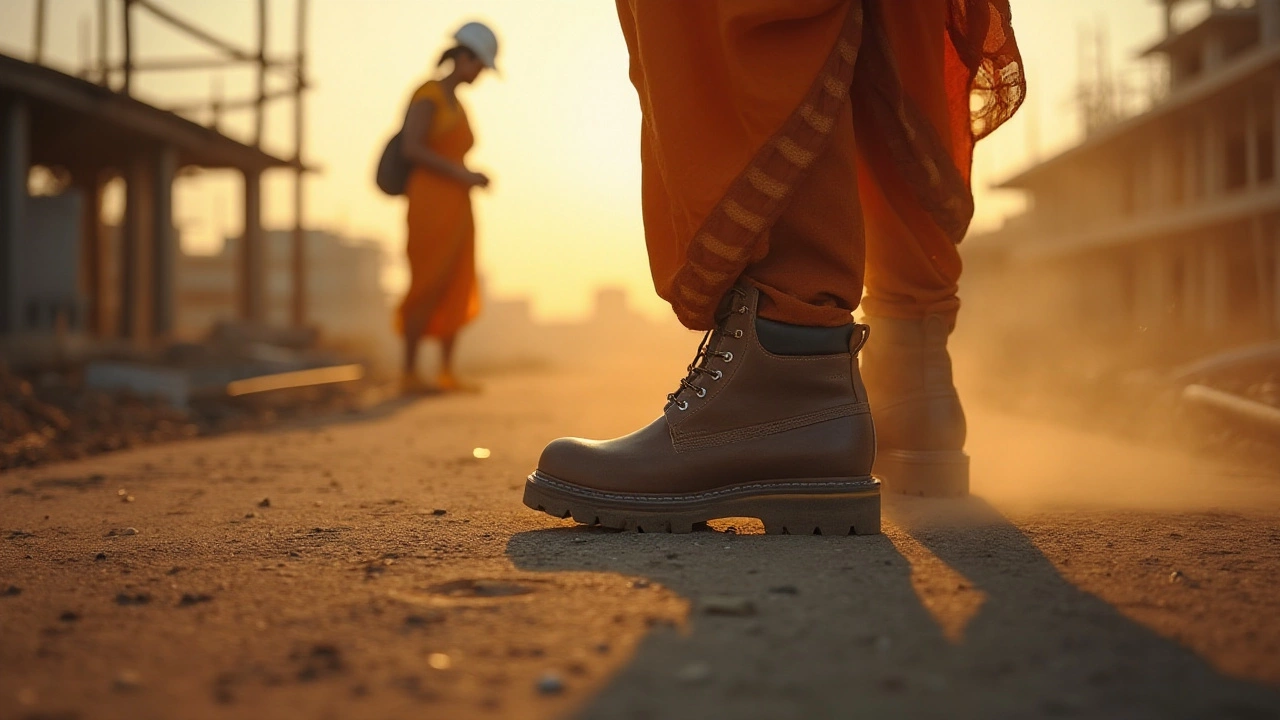Anyone who's pulled a series of three 12-hour shifts knows it's not for the faint-hearted. These marathon stints press the body and mind into a tiring routine, testing resilience and stamina.
While the fatigue may be inevitable, wearing the right shoes makes all the difference, offering support and comfort that can prevent aches and even more serious physical issues.
In the hustle and bustle of long shifts, having reliable footwear is like having a trusty sidekick capable of weathering any storm with you.
By honing in on key features that make a shoe conducive to lengthy hours on your feet, you can glide through your shift with less discomfort and more focus. A careful selection can be the secret to surviving and thriving during these exhausting shifts.
- Challenges of 3 12-Hour Shifts
- Importance of Comfortable Work Shoes
- Features to Look for in Work Shoes
- Tips for Managing Long Shifts
Challenges of 3 12-Hour Shifts
Three consecutive 12-hour shifts can be an intense grind that tests one's physical endurance and mental toughness. The sheer length of these shifts often means spending extensive time on your feet, which can lead to a range of physical problems. Common issues include muscle fatigue, joint pain, and even more serious afflictions such as lower back pain or plantar fasciitis. Such ailments make each subsequent shift increasingly challenging, especially without adequate recovery time.
Mentally, these long shifts can be just as demanding. Maintaining focus and alertness for such extended periods requires considerable mental stamina. The lack of natural light during overnight shifts can disorient the body's internal clock, leading to fatigue and decreased cognitive function. Additionally, sleep deprivation is a genuine concern, as a disrupted sleep cycle impacts both health and performance.
Social life can take a hit as well. Working such shifts chronically interferes with one’s ability to maintain relationships and partake in family gatherings or social activities, often causing feelings of isolation. For those in caring professions, such as healthcare, the emotional demands of a 12-hour shift can be particularly taxing, potentially leading to burnout. Stress management becomes crucial, and learning to find a work-life balance is a vital skill.
One key element is how well the body is prepared for these demands. Choosing the right work shoes plays a substantial role in this preparation. The right footwear provides the foundation for physical endurance during these shifts. Effective strategies for counteracting the challenges of 12-hour shifts include regular breaks, stretching routines, and mindfulness practices to maintain both physical and mental well-being.
"Working long shifts takes a physical and emotional toll, but recognizing the signs of fatigue and proactively managing stress can mitigate those effects," shared Dr. Lisa Thompson, an occupational health expert, in her widely-read guide on workplace well-being.
The impact on health can also be measured statistically. Workers with prolonged shift schedules are at a higher risk for chronic conditions such as obesity, heart disease, and diabetes. Considering these challenges, it becomes crucial for organizations to support their employees in managing these demanding hours by providing resources and promoting healthy practices.
The Importance of Comfortable Work Shoes
When tackling three consecutive 12-hour shifts, the significance of comfortable work shoes cannot be overstated. Imagine being on your feet for the better part of the day, continuously moving, bending, and standing. It's a real test not just of endurance but also of the tools you rely on to get through. Shoes can be one of the most critical pieces of equipment, second only to the skills you bring to your work. The wrong pair can lead to discomfort, pain, and potential long-term health issues like plantar fasciitis or back problems.
Proper footwear offers more than just comfort; it provides essential support that maintains posture and reduces strain on your body. This includes cushioning, arch support, and shock absorption. A well-designed shoe absorbs impact shock as you step, diminishing the stress on your joints, which makes a significant difference when multiplied over thousands of steps each shift. This can be particularly true if your job requires you to move rapidly or on diverse surfaces.
Moreover, a reliable shoe ensures safety during work. Many shoes designed for long shifts come with features like non-slip soles or waterproof materials, tailored to the specific risks of certain environments, such as hospital floors or greasy kitchen surfaces. Ignoring the need for a good shoe could lead to unfortunate slip-ups or falls, which could mean time off from work or, worse, serious injury.
Similarly, selecting the right shoe affects morale and productivity. Discomfort from subpar shoes can distract, making it harder to focus on tasks. As noted by the American Podiatric Medical Association, investing in supportive footwear minimizes fatigue, empowering workers to stay efficient and maintain high performance levels across demanding shifts.
"Good shoes take you to good places", and in this context, good places mean a reduced probability of foot-related injuries and discomfort, which keeps workers in top form.
—Podiatry Today
Interestingly, a study from the National Institute of Occupational Safety and Health revealed that a well-engineered shoe could improve job satisfaction and reduce absenteeism. While this can be a lesser-considered benefit, it becomes clear that the ripple effect of comfort is substantial. Pain and discomfort don't just affect physical health; they bleed into psychological wellness too. Feeling physically restricted or in pain can quickly diminish enthusiasm, leading to decreased work satisfaction and higher instances of burnout.
Therefore, those facing the rigors of 12-hour shifts should never overlook the power of appropriate work shoes. It’s not simply about comfort—it’s about ensuring a harmonious blend of safety, support, and efficiency. Making an informed choice allows individuals to not only survive through long hours but to do so with minimal physical cost, bringing out the best in both work and personal life. Ultimately, choosing the right pair of shoes is an investment in one's health and happiness over the long haul.

Features to Look for in Work Shoes
When it comes to conquering those arduous 12-hour shifts, the right pair of work shoes can be your best ally. It's not just about aesthetics or following trends; it goes deeper into comfort, practicality, and the ability to keep your feet healthy over long periods of demand. One critical feature you should seek is adequate cushioning, as it acts as a barrier against the relentless pounding your feet endure, cushioning each step and absorbing shock. This padding is crucial, particularly for those working on unforgiving surfaces like concrete or tiles, where each footfall can feel like a sledgehammer if left unprotected. Moreover, shoes with adequate arch support can do wonders for your posture and gait. Improper support may lead to chronic pain not only in the feet but extending up the kinetic chain to the knees, hips, and lower back, altering how you carry your body and possibly leading to fatigue even when you're not on the clock.
Equally essential is the shoe's material. Breathability should never be overlooked because preventing moisture buildup is critical during extended wear. Materials like mesh or leather allow air circulation, keeping your feet cool and dry and preventing conditions such as athlete's foot. Durability also plays a key role; high-quality materials stand the test of time and wear, saving you from frequently replacing your footwear and sparing your wallet in the long run. A slip-resistant sole is yet another essential feature, offering vital safety on surfaces that might be wet or oily. The grip not only ensures your security but allows you to move swiftly without fear of slipping, which is particularly important in professions like healthcare or restaurant work where quick pace and precision are routine. A durable, non-slip base offers peace of mind and lets you focus on your shift's responsibilities without the side concern of a possible slip-and-trip.
Another key consideration is the shoe's fit. An ill-fitting shoe can quickly become a bane, rubbing against the skin to cause blisters or calluses and even leading to more severe issues such as bunions or hammertoes. Look for shoes with a wide toe box to give your toes wiggle room, and consider shoes available in adjustable widths. It's wise to try different models and sizes toward the end of the day when your feet are likely more swollen, mimicking how they might feel after hours of work. Comfort is crucial, but style doesn't have to be sacrificed. With ergonomic designs available in a myriad of styles, finding something that ticks all the boxes is an attainable goal. Remember, investing the time upfront for the perfect fit pays dividends when you're in mile eight of a double shift.
According to Dr. Howard Friedman, a renowned podiatrist, "The right shoe can make all the difference for someone logging long hours on their feet. So many foot health issues are preventable with proper footwear. It's critical that individuals understand this as it can have lifespan benefits."
Finally, advanced technology is steadily making its way into the footwear industry. Features such as anti-fatigue technology, which aids in energy conservation, can really bolster endurance through those last hours of the shift. Some shoes incorporate memory foam and moisture-wicking linings that serve not only in comfort but in hygiene and longevity. While these might seem like bells and whistles, for workers who face long shifts regularly, these subtle aids could be the ultimate game-changers. When shopping for new work shoes, an awareness of these advanced features might steer your decision to the perfect pair, ensuring you walk into every shift ready to face the demands ahead.
Tips for Managing Long Shifts
So you're about to tackle another set of 3 12-hour shifts. You’ve got the work shoes sorted, which is a great start, but there’s more to keeping yourself in top shape over the course of these lengthy hours. Managing long shifts requires more than just physical preparedness; it's also about mental fortitude and efficient time management. Like any marathon, pacing yourself is crucial. Begin by mapping out your tasks. Tackling your workload in smaller, manageable chunks can prevent the sensation of being overwhelmed. Utilize techniques like the Pomodoro Technique, where work periods are interspersed with short breaks, to maintain productivity while giving your brain a much-needed pit stop.
Stay Nourished and Hydrated
Nutrition plays a pivotal role in enduring long hours on your feet. A balanced diet, rich in complex carbohydrates, proteins, and healthy fats, fuels your energy levels and cognitive functions. Don’t underestimate the power of small snacks; fruits, nuts, and granola bars are excellent for quick boosts. Hydration is equally important, as even mild dehydration can lead to fatigue and reduced alertness. Keep a water bottle handy and take regular sips rather than waiting until thirst hits you.
Stay Active and Rest
Balancing activity and rest is vital. While it might sound contradictory, incorporating short bursts of physical activity into your routine can stave off fatigue. Simple stretching or a brisk walk can invigorate your muscles and refresh your mind. On the flip side, when you get home, unwinding and providing your body ample time to rest and recover is just as essential. Establish a post-shift routine that includes activities like warm baths, reading, or meditation to ease your transition to relaxation mode.
Wear the Right Gear
While work shoes grab the spotlight, don’t forget the rest of your gear. Clothing that offers comfort and flexibility supports your body during long shifts. Opt for breathable materials and layers, especially if working in environments with fluctuating temperatures. Compression socks can aid in circulation, reducing the likelihood of leg fatigue and swelling.
“It always seems impossible until it’s done.” - Nelson Mandela
With perseverance, the end of a long shift becomes a manageable goal instead of a distant dream. By equipping yourself with effective strategies and the right mindset, those grueling stretches of hours transform into opportunities for accomplishing great work and mastering time management. Remember, as with any challenge, each long shift conquered is a testament to your resilience and dedication.
